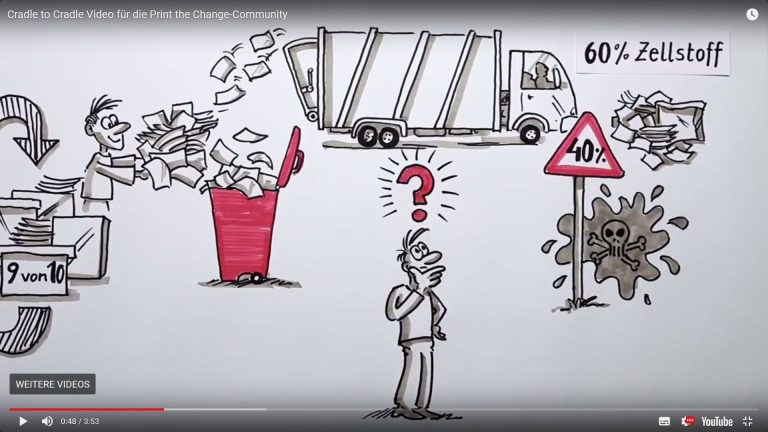Everybody wants to go green, and initiatives that parade all kinds of green before them like a banner blossom. Also in the printing industry. Not all of them are conclusive, there are self-designed claims that propose undeinkable UV-curable inks and printing processes for being mineral-oil free, similar claims come for soy based inks.
For many years, the Cradle to Cradle Initiative (C2C) claims the revolution in eco-friendly printing: “As a prerequisite, the production must meet the criteria of sustainability, high-end quality and competitive prices.” Basically, some ideas are familiar, like recovering valuable resources such as fibres. But some of the claims of the initiative again fail to be conclusive, leading producers towards a certificate that has to be renewed every two years – and purchased from the “Cradle to Cradle Products Innovation Institute”, a designation that leads to a group of “assessors” – and to EPEA, the environmental institute of Michael Braungart, who after working for Greenpeace has been in the business of ecodesign for more than 30 years.
Green business as a concept
The Cradle to Cradle certification is available for products from t-shirts to shampoo. For printed products it is aimed at the “biological cycle” and lists a variety of papers without revealing the producers, to be obtained only at one Austrian printer who is certified for a list of “Pureprint” papers and inks. But this list has products that might be compostable but not deinkable and therefore recyclable in the way normally the household paper goes: Under the label “Pureprint jewel” a “mineral paper” is promoted, a contradictory in terms – “Rock Paper”. This material “made from crushed limestone (…) is strong and waterproof”, should better be labelled “rock foil” as it does not fulfil the usual definition of paper, to be made from fibres. And it is among the unrecyclable papers that only contribute to the costly waste fraction if they accidentally enter the recycling process. The website of the German distributor claims that this rock-plastic compound is “the first environmentally friendly paper”.

In principle, there is nothing wrong about children’s books to be edible, if they were also deinkable. But also for years, the Austrian C2C-printer Gugler has promoted compostable printing products with a video presenting “alternative facts” about paper recycling, especially the deinking process: Only 60 percent of the fibres are recovered, this cartoon states, up to 40 percent are “more or less poisonous sludge”. INGEDE has approached Gugler many times already about the questionable nature of these claims, but Gugler keeps referring to EPEA to be the scientific advisor of the content. The video is also a lead on the website of “Print the Change” that promotes Gugler and a small Danish printer: KLS PurePrint. Here the circle closes, as KLS is one of the promoters of Cradle to Cradle certified rock foil.
Now there is another piece in the puzzle around the C2C initiative that gives the whole idea a broader perspective and wants to attract more customers for the project: With the “Healthy Printing Initiative” and a related “Healthy Printing Symposium”, EPEA aims at “scaling up innovation and demand for healthy printing products”. What is healthy printing? Among the activities: “Certifying inks. The number and variety of C2C-certified inks is expanding!”
With preserving resources being a common target of both INGEDE and the Healthy Printing Initiative, also the idea of full recyclability (and deinkability) will be introduced into the concept – and finally the claims about the toxic nature of 40 percent more or less poisonous sludge coming from deinking will be given another consideration. And INGEDE will offer more substantial input than currently available – a German paper on “Sustainable Design of Print Products”, meant to promote the ideas of the “Healthy Printing Initiative”, still shows some lack of knowledge in the field of paper production and recycling. It states that “millions of tons of problematic sludge are produced” in the “water-intensive, so-called ‘deinking’ process”. As a first attempt Dr. Thomas Krauthauf, Chairman of INGEDE, will give a presentation at the Healthy Printing Symposium, informing about the deinking residues as desirable raw material for bricks and cement rather than being “poisonous sludge”.
You can download Thomas Krauthauf’s presentation “Recycling of Graphic Paper Products – Challenges and Trends” here as pdf.
Axel Fischer
Theme: Illdy. © Copyright INGEDE 2024. All Rights Reserved. All pictures copyrighted.
